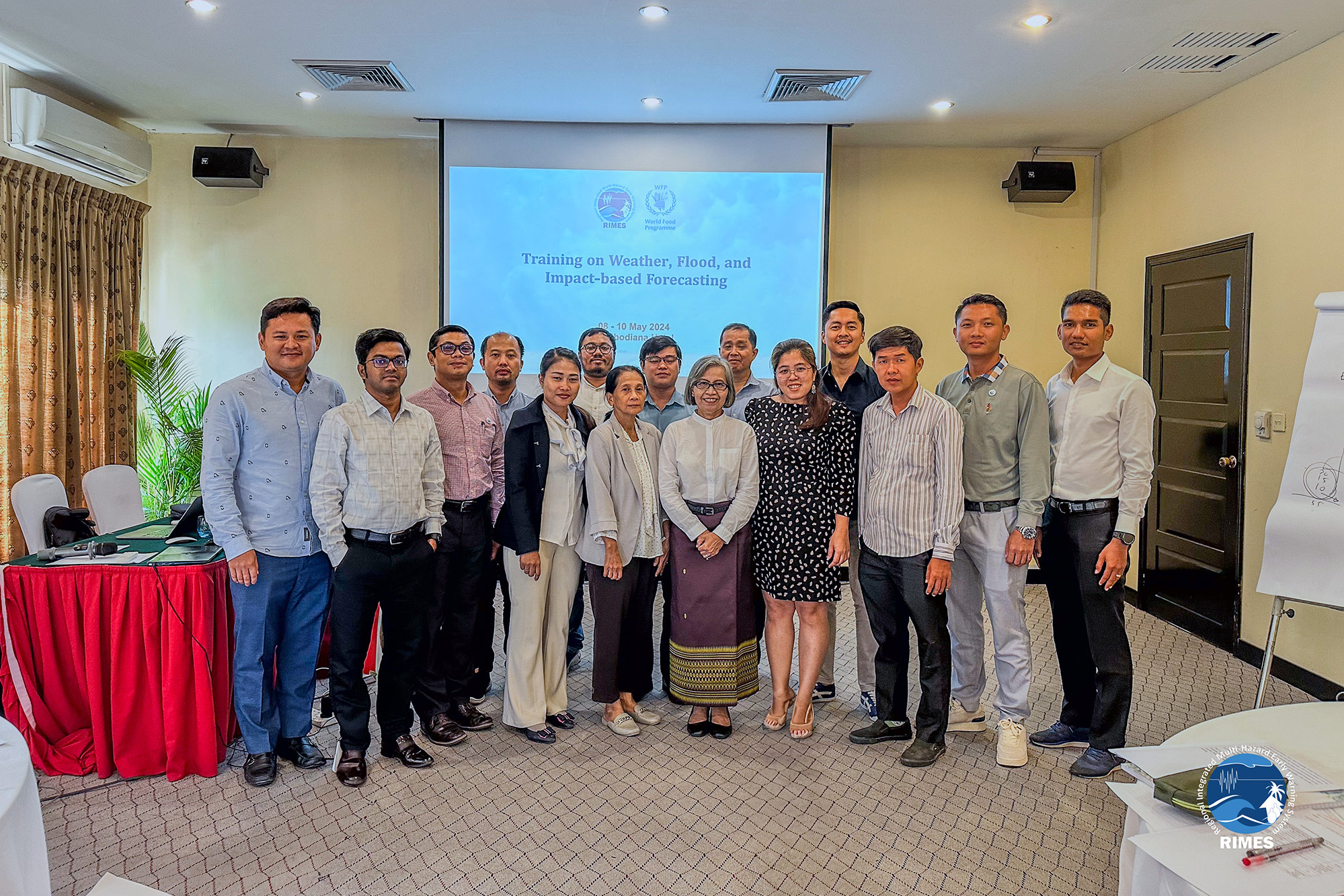
Group photo of the participants and resource persons during a capacity building in Cambodia
Cambodia's fertile rice paddies, nurtured by the mighty Mekong River, are constantly threatened by devastating floods. Recognizing this risk, the Cambodian government has recently prioritized improving its hydro-meteorological capabilities, particularly in impact-based flood forecasting (IbF).
IbF is an emerging practice that shifts weather prediction to focus on the potential consequences of weather events. This approach enables communities and authorities to take proactive measures before a disaster strikes.
Historically, Cambodia has faced significant hurdles in forecasting capabilities. The Ministry of Water Resources and Meteorology (MOWRAM), including its Department of Meteorology (DOM) and Department of Hydrology and River Works (DHRW), struggled with outdated tools and limited resources.
“The tools we are using at the moment can only provide 3-day bulletins and reference historical data to validate the forecasts; a 15-day weather forecast would be very helpful so we can prepare accordingly, especially for extreme events,” shares Som Kungsomreth, Hydrology Officer at the DHRW.
WFP-RIMES Project
The World Food Programme (WFP) partnered with the Regional Integrated Multi-Hazard Early Warning System for Africa and Asia (RIMES) to implement the project, "Development of Early Warning Systems to Enable Anticipatory Action Plan for Floods in Selected River Basins in Cambodia." This initiative aims to strengthen the country’s resilience to climate hazards by enhancing the forecasting and anticipatory action capacities of national and sub-national institutions.
Anticipatory action utilizes IbF data to trigger pre-planned actions that mitigate the impact of impending disasters. These proactive measures are crucial for safeguarding lives, livelihoods, properties, and infrastructure. The collaboration between hydrometeorological agencies and at-risk communities in designing and implementing IBF and AA programs is key to transforming early warnings into effective early actions.
To improve the fundamentals of weather and flood forecasting capabilities of MOWRAM, DOM, and DHRW, a three-day training program was conducted by WFP and RIMES. This program focused on enhancing skills in flood frequency analysis, basin average rainfall calculation, and threshold determination.
DataEx for Improved Forecasting
RIMES introduced its Data Exchange (DataEx) platform, a state-of-the-art meteorological data exchange, visualization, and analytics system. This platform enables the secure exchange of country-specific meteorological data and provides access to forecast products from global producing centers like the European Centre for Medium-Range Weather Forecasts (ECMWF). By integrating real-time data and advanced analytics, DataEx revolutionizes forecasting approaches, enabling more accurate and localized predictions.
“DataEx could transform our capabilities by integrating various models and satellite data, allowing us to extend forecasts up to 15 days and predict flash floods in previously unmonitored areas. This tool could be a game-changer for our operations,” said Kungsomreth.
Similarly, Mr. Thaily Oy, Vice Chief of the Weather Observation Office in DOM, emphasized the benefits of DataEx: “This platform offers a range of forecasting techniques and models, enhancing the accuracy of forecasting. It’s our first exposure to such comprehensive data integration and analysis, and it’s proving invaluable. However, we would need more time and training to further explore and discover the features of DataEx.”
The training also covered probabilistic versus deterministic forecasts, threshold determination, vulnerability assessments, and the principles of IBF. The modules equipped participants with a deeper understanding of forecasting uncertainties, the importance of accurate threshold setting, and the need for people-centered early warning systems.
“Such trainings are warmly welcomed in our institutions. Cambodian universities currently do not offer hydrological and meteorological courses, so we rely on passing knowledge to our new colleagues,” expressed Kungsomreth.
As the project moves forward, the focus will be on providing more training opportunities for key stakeholders, customizing DataEx for specific regional needs, and finalizing and testing of the Anticipatory Action Plan for floods to ultimately be integrated into Cambodia’s disaster preparedness mechanisms.
The story of DataEx in Cambodia is not just about technological advancement; it’s about building a foundation of resilience through innovation, collaboration, and a commitment to protecting communities from the impacts of natural hazards. (30)